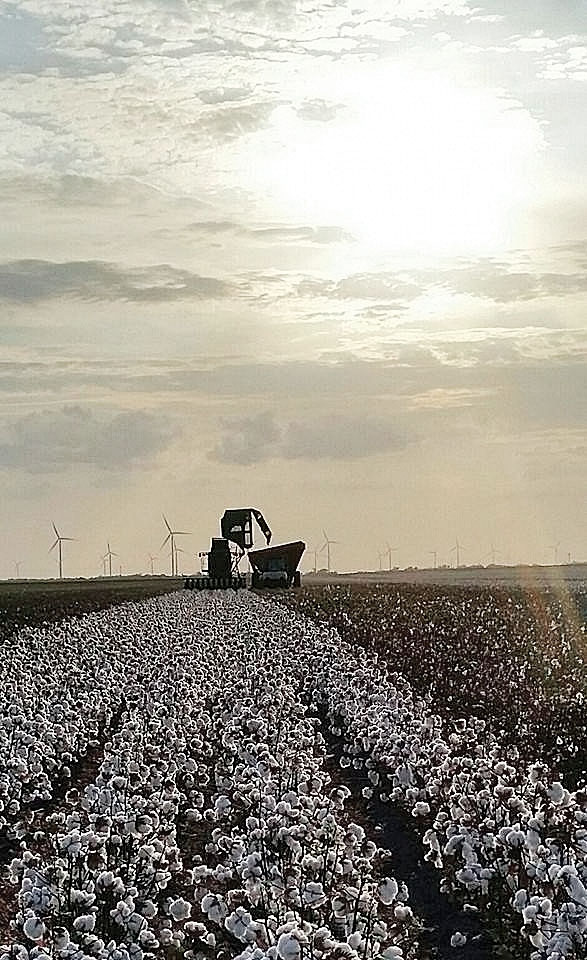- La Feria Native Soon To Retire From The Military This Summer
- Senior Eneece Avila Takes Pride in her State Title
- Dr. Noemi Infante, Harlingen Medical Center Open New Women’s Clinic
- Santa Rosa Cameron County Park Partially Reopens
- Santa Rosa Takes to Regionals Meet in Kingsville, Tx
- Long-Standing Nexstar Tower in La Feria Decommissioned
- Lionettes Powerlifting Meet
- Local Business Holds Event to Benefit RGV Shriners Club
- Knights of Columbus Holds it’s 30th Annual Golf Tournament
- KGBT Tower Dismantled
Texas Cotton: Harvest Off to Good Start in Rio Grande Valley
- Updated: August 29, 2014

The work continues at all hours to get the cotton to market
By Rod Santa Ana, Texas AgriLife, AgFax.Com
Continued hot, dry weather is all that’s needed to help Rio Grande Valley cotton growers forget last year’s disappointing crop and harvest a bountiful, successful crop for 2014, according to Texas A&M AgriLife Extension Service experts.
“It was a tough year for Valley cotton growers last year,” said Brad Cowan, AgriLife Extension agent for Hidalgo County. “Between prevented planting we had on many irrigated acres due to a shortage of irrigation water and a lack of rainfall that caused most of our dryland cotton acres to fail, it was pretty dismal around here.”
While a few lucky growers got the moisture they needed to produce high yields of four bales per acre, most did not, he said.
“Overall, only a little over 60,000 bales were produced in 2013,” Cowan said. “That’s a very low figure for this production area, and the lowest since 1995.”
But this year is shaping up to be a big turnaround.
“We had rains that started last year during harvest and into September, then more in the wintertime and spring,” he said. “Because of all the rain, it was a challenge to harvest last year’s crop, but that rain helped replenish deep soil moisture that we desperately needed. It’s one reason our current crop is looking really good and has a lot of potential.”
Yields are especially encouraging.
“The dryland crop is already pretty much harvested. A lot of that is up to two bales per acre, which is above average, and there’s a potential for the irrigated crop to be three to three and a half bales per acre.”

Two generations of the Taubert Farm Family
Rain-free days through August, though, would help keep harvesters moving to get the area’s 145,000 acre crop safely into cotton gins, Cowan said.
“The irrigated cotton crop is still out in the field, and we don’t count our chickens before they hatch, but with good harvest weather, we’re hoping for an excellent irrigated crop here in the Rio Grande Valley.”
Danielle Sekula-Ortiz, an AgriLife Extension integrated pest management agent in Weslaco, said insects were not a major problem this season.
“This year we had a late start getting cotton planted due to the moisture we received in rainfall early on,” she said. “We had some pest problems early in the season, like fleahoppers during squaring, but other than that, it was a pretty light pest season. That was good because many growers were having to spray for sugarcane aphids in grain sorghum to protect their crops.”
Cowan said the lack of boll weevils in Valley cotton fields is a blessing.
“The Boll Weevil Eradication Foundation has done a tremendous job of ridding Valley cotton crops of its major pest,” he said. “This cotton crop is not being affected by the boll weevil. In fact, it’s been unusual to see boll weevils in our cotton fields for the last couple of years. We’re now learning how to grow cotton without the pressure of the boll weevils.”
Possible concerns for growers this year, Cowan said, were the lack of what’s called a bottom crop and the downward trend of world cotton market prices.
“We’re seeing on both dryland and irrigated cottona lack of cotton bolls on the lower branches of the plants, the bottom crop,” he said. “This could be due to early pest infestations and/or cool weather early in the season. Sometimes the loss of bolls on the bottom branches will be made up for with heavier loads on the upper branches, but we’ll just have to see the end figures after harvest.”
Lower market prices, though, are evident right now, Cowan said.
“Prices are terrible. They’re weakening. Futures prices are at about 64 to 65 cents per pound of lint, which is way off last year’s average of 75 cents. There are a whole host of reasons for lower prices, including market pressures, crop outlook, demand, and of course, the fact that China still sits on lots of cotton in storage.”
Because growers planted later than usual, many may have to scramble to destroy their stalks after harvest by Sept. 1 as mandated by state law, Sekula-Ortiz said. Destroying stalks, either mechanically or chemically, keeps boll weevils from surviving and multiplying in regrowth and volunteer cotton.
“It’s important to practice timely and effective stalk destruction,” she said. “It has been proven that stalk destruction is key to controlling boll weevil populations by disrupting their life cycles to avoid overwintering.”
by Karen TaubertWhen asked if the La Feria News could use a few of her nice photos Karen Taubert replied, “I would be honored if you would share the love! We have something special down here in the Valley. Amidst all the negative press and drama over the border wars, drug trafficking, and human smuggling; harvest season is a reminder that there is beauty all around us and a power at work that is bigger than all our worldly problems”. These photos were taken at Taubert Farms located in the Rio Hondo area. |






